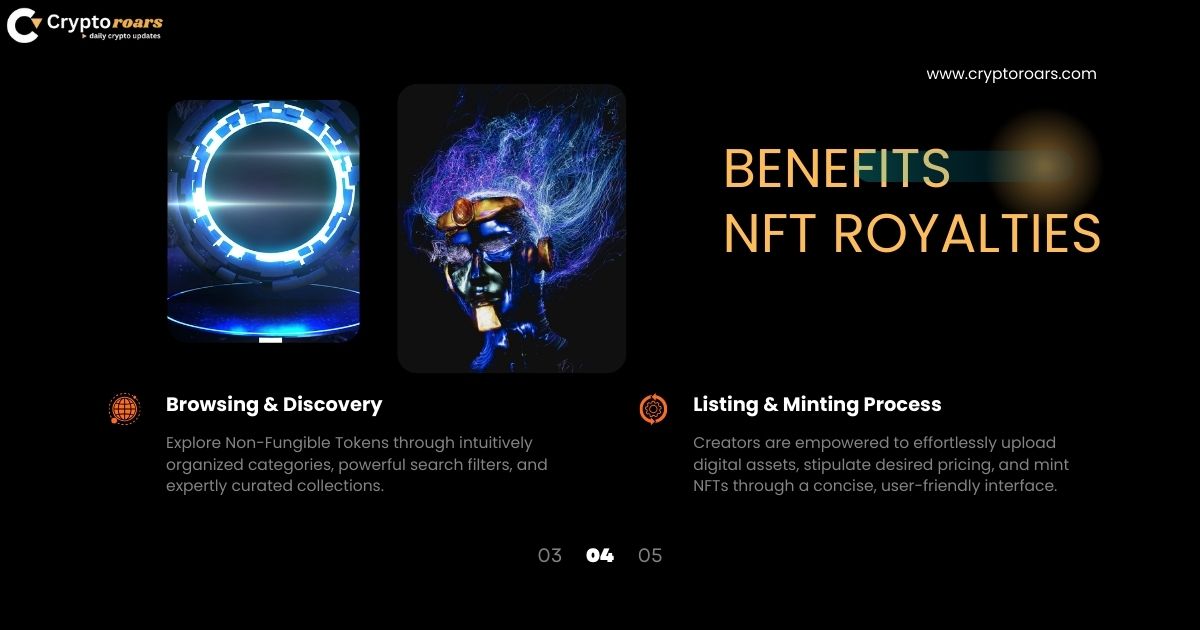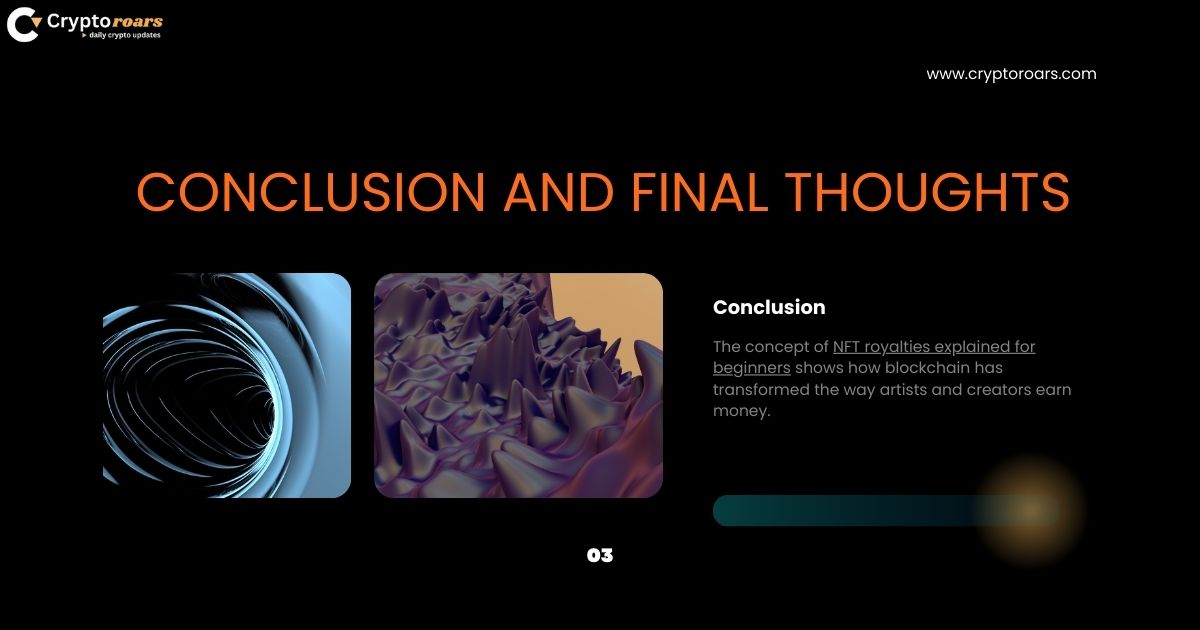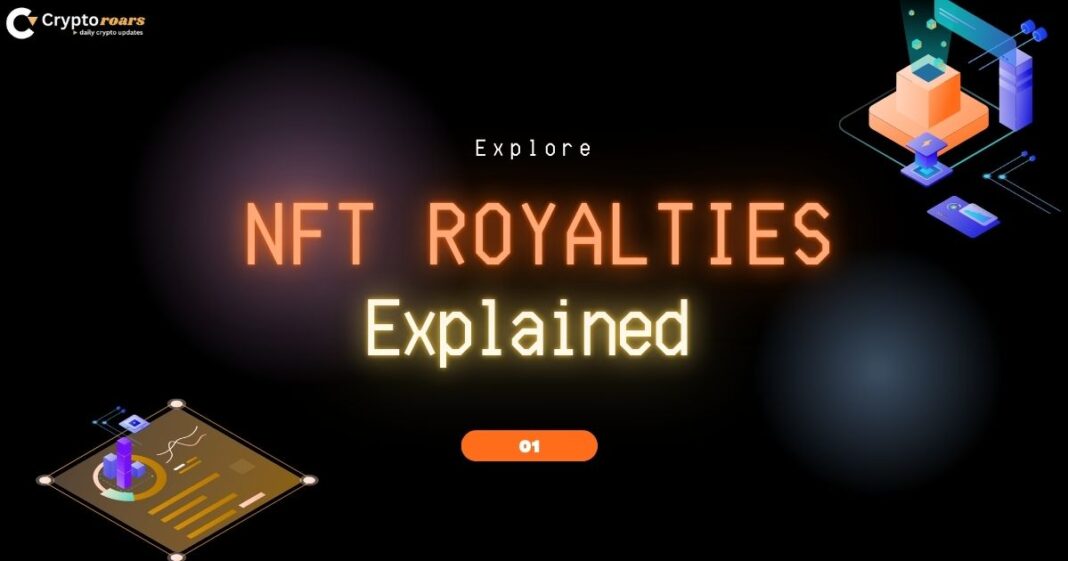Introduction to NFT Royalties
The world of digital assets is changing fast, and NFT royalties explained for beginners has become a major topic in 2025. NFTs, or non-fungible tokens, allow creators to sell digital items such as art, music, collectibles, and even in-game items. What makes them unique is the ability to program royalty payments directly into the asset. Every time a digital asset is resold, the creator can earn a percentage from that digital asset resale. Unlike traditional art sales, where the creator only earns once, NFTs allow creators to earn passive income from NFTs long after the first sale.
The growth of NFT marketplaces like OpenSea, Rarible, Blur, and others has made it possible for artists, musicians, and brands to benefit from secondary sales royalties. With the use of smart contracts in NFTs, royalties are processed automatically without middlemen. This shift has brought new opportunities for NFT artists, NFT collectors, and the wider community. It has also raised important debates such as “Are NFT royalties reliable?”, the “removing NFT royalties debate”, and the future of NFT royalties in a world moving toward Web3.
What Are NFT Royalties?
NFT royalties are programmed fees that creators earn every time their NFT is resold on the secondary market. These royalties are automated through smart contracts for royalties, which are pieces of code written into the blockchain when the NFT is created. When a resale happens, the contract ensures that the creator receives a pre-set percentage of the sale price. This ensures fair digital artists’ compensation and secures their resale rights.
For instance, if a creator sets a NFT royalties percentage of 8%, they will receive 8% of the selling price each time the NFT changes hands. This creates a system of blockchain royalties that cannot be altered without changing the contract. As more artists explore NFTs, the impact of NFT royalties is becoming central to the growth of the creator-friendly NFT ecosystem. It allows musicians, writers, and visual creators to build long-term revenue models beyond their initial sales.
Why NFT Royalties Are Important for Creators
Traditional markets rarely offer artists long-term earnings from their work. When a painting or song is resold, the artist usually gains nothing. However, NFT royalties vs traditional royalties show how the blockchain model is more rewarding. By including secondary sales royalties, creators can continue to profit from the value of their work as it increases over time.
This system is especially vital for digital creators who previously had little control over digital ownership or digital asset resale. Now, with NFT royalties as passive earnings, artists can maintain a sustainable income even if they stop producing new works. This is why creator earnings from NFTs are considered one of the most revolutionary aspects of Web3.
How Do NFT Royalties Work in Blockchain?
The key to answering “How do NFT royalties work?” lies in smart contracts in NFTs. When an NFT is minted, the creator sets a percentage of royalties. Each time the NFT is sold on a supported marketplace, the blockchain verifies the transaction, and the smart contract automatically transfers the royalty fee to the creator’s wallet. This automated transfer of NFT royalties ensures trust and removes the need for lawyers or middlemen.
However, the system depends on marketplace policies. Some platforms support enforced royalties, while others leave it as optional royalties. The significance of optional royalties is currently debated, as collectors often prefer marketplaces where fees can be avoided. This creates ongoing royalty enforcement challenges that shape the direction of secondary NFT market conditions.
Understanding Royalty Percentages in NFTs
Creators usually decide what NFT royalties percentage they want at the time of minting. This can range from 2% to as high as 15%. For example, music NFT royalties often carry higher percentages compared to visual art because the resale value of music-based NFTs is generally lower.
The table below shows average royalty percentages on major platforms:
| NFT Marketplace | Average Royalty Percentage | Supports Optional or Enforced Royalties |
| OpenSea | 5%–10% | Optional |
| Rarible | 5%–15% | Enforced |
| Blur | 0%–5% | Optional |
| Magic Eden | 5%–10% | Enforced (on Solana NFTs) |
| Cardano Marketplaces | 2%–10% | Enforced |
These royalty payments are critical for ensuring that NFT artists can build sustainable businesses. The ongoing discussion about the removing NFT royalties debate shows that the percentage chosen has a direct effect on both NFT collectors and creator earnings.
Benefits of NFT Royalties for the Ecosystem

The impact is not limited to creators alone. A creator-friendly NFT ecosystem benefits the entire community by encouraging innovation, protecting resale rights, and supporting long-term digital ownership. When creators are fairly rewarded, they continue to build projects that attract more collectors, which increases overall NFT trading volume on Cardano, Ethereum, and Solana.
Royalties also provide stability in secondary NFT market conditions. Collectors know that part of their purchase goes back to supporting the artist, which creates goodwill and strengthens trust between buyers and sellers. In addition, royalties help build sustainable models for NFT marketplaces, ensuring they remain profitable while supporting innovation.
Challenges and Limitations of NFT Royalties
Despite the benefits, there are major obstacles. The most pressing issue is royalty enforcement challenges. Since optional royalties are allowed on some platforms, collectors often avoid paying fees, which reduces creator earnings. This has fueled the removal of NFT royalties debate, where some marketplaces argue that flexibility attracts more trading volume.
Another limitation is the lack of interoperability of NFTs. Royalties set on one marketplace do not always transfer across different platforms, leading to inconsistencies. This weakens the system and makes people question, “Are NFT royalties reliable?” Until a universal standard is created, these problems will continue to affect the transfer of NFT royalties across multiple chains.
NFT Royalties vs Traditional Royalties
When comparing NFT royalties vs traditional royalties, the difference is clear. Traditional royalties in art and music depend on contracts, publishers, and collecting societies. These involve heavy legal work and slow payment systems. In contrast, blockchain royalties are instant, transparent, and enforced by code.
Another major difference lies in digital ownership. In the physical world, resale profits rarely reach the original creator. But with secondary sales royalties, creators can continuously earn from the growing value of their work. This is why NFTs are now seen as a better solution for digital artists’ compensation in the long run.
Who Really Gains from NFT Royalties?
The biggest winners are creators. NFT royalties as passive earnings allow artists to build wealth while focusing on new projects. Musicians can enjoy music NFT royalties, visual artists benefit from digital asset resale, and writers can even tokenize digital books with built-in royalties.
Collectors also benefit indirectly. Knowing that artists receive continuous support fosters a healthier community and increases the long-term value of NFTs. However, there are times when NFT collectors argue that high royalty fees reduce their profits. This balance between creator earnings and collector profits continues to shape marketplace policies worldwide.
Role of Marketplaces in Enforcing NFT Royalties
NFT marketplaces play the most crucial role in deciding whether royalties are optional or enforced. For example, royalties on Rarible and OpenSea are treated differently. Rarible enforces royalties while OpenSea allows them to be optional, which has sparked major debate in the industry.
The enforcement model is seen as more supportive of a creator-friendly NFT ecosystem, while the optional model favors traders. The outcome of this debate will determine how secondary NFT market conditions evolve in the coming years.
Top NFT Marketplaces That Support Royalties
There are several platforms known for supporting royalty payments:
- Rarible – Enforces royalties strictly and supports creator earnings.
- OpenSea – Introduced optional royalties, which caused the removal ofthe NFT royalties debate.
- Magic Eden – A major player for Solana NFTs, enforcing royalties on most collections.
- Cardano NFT ecosystem – Enforces NFT trading volume on Cardano with transparent royalty systems.
- Zora – Popular for experimental and creator-friendly NFT ecosystem policies.
These marketplaces prove how much influence marketplace policies have over the impact of NFT royalties.
Legal Aspects of NFT Royalties and Copyright
Legally, royalties raise questions about ownership, contracts, and enforcement. While smart contracts for royalties ensure payments on-chain, traditional laws about digital artists’ compensation are still evolving. In the United States, courts are still deciding whether resale rights apply automatically under copyright laws.
The lack of international legal standards creates risk for NFT collectors and creators. While blockchain royalties are enforced by code, disputes may still arise over the transfer of NFT royalties when tokens move between platforms. This legal uncertainty is one of the reasons people ask, “Are NFT royalties reliable?”
How to Set Up Royalties When Minting an NFT
When creators mint NFTs, they can set their NFT royalties percentage directly. Most NFT marketplaces have built-in tools that allow artists to define the percentage of royalty payments. Once the NFT is created, the smart contracts in NFTs ensure automatic transfer of NFT royalties during resale.
Creators should study marketplace policies before minting. Choosing between optional royalties or enforced royalties can greatly affect long-term creator earnings. Artists looking for stability often prefer platforms like Rarible, Cardano-based marketplaces, or Solana’s Magic Eden.
Case Studies of NFT Royalties in Action
One of the best examples is the Beeple Crossroads NFT example. Beeple earned millions from initial sales, but he also continued to make money from secondary sales royalties each time the artwork was resold. This shows how NFT royalties as passive earnings work in real practice.
In the music industry, music NFT royalties have helped independent artists bypass record labels and earn directly from fans. These creators gain digital artists’ compensation while building loyal communities. The combination of secondary NFT market conditions and creator-friendly NFT ecosystem models is shaping the entire entertainment industry.
The Future of NFT Royalties in Web3
The future of these royalties depends on resolving issues like the removal of NFT royalties debate, royalty enforcement challenges, and interoperability of NFTs. As Ethereum NFTs, Solana NFTs, and the Cardano NFT ecosystem grow, the industry will likely move toward global standards.
Experts believe that strong marketplace policies, improved secondary sales royalties, and universal contracts will strengthen the system. With advancements in smart contracts for royalties, creators will continue to enjoy NFT royalties as passive earnings, making Web3 a truly sustainable model for digital ownership.
Frequently Asked Questions (FAQs)
1. How do NFT royalties work?
They work through blockchain smart contracts in NFTs that automatically send royalty payments to creators during resales.
2. Are NFT royalties reliable?
They are reliant on marketplaces that enforce them, but optional platforms create uncertainty.
3. What is the NFT royalties percentage?
It usually ranges between 2% and 15%, depending on the platform and the creator’s choice.
4. What is the impact of NFT royalties?
They provide long-term income for creators, encourage innovation, and strengthen the NFT economy.
5. What is the future of NFT royalties?
The future of these royalties will likely involve universal enforcement, better legal standards, and stronger interoperability across blockchains.
Conclusion and Final Thoughts

The concept of NFT royalties explained for beginners shows how blockchain has transformed the way artists and creators earn money. Through secondary sales royalties, creator earnings are protected in a way that never existed before. However, challenges such as royalty enforcement challenges, the significance of optional royalties, and the removal of NFT royalties debate show that the system is still evolving.
For more information, keep visiting cryptoroars.com


